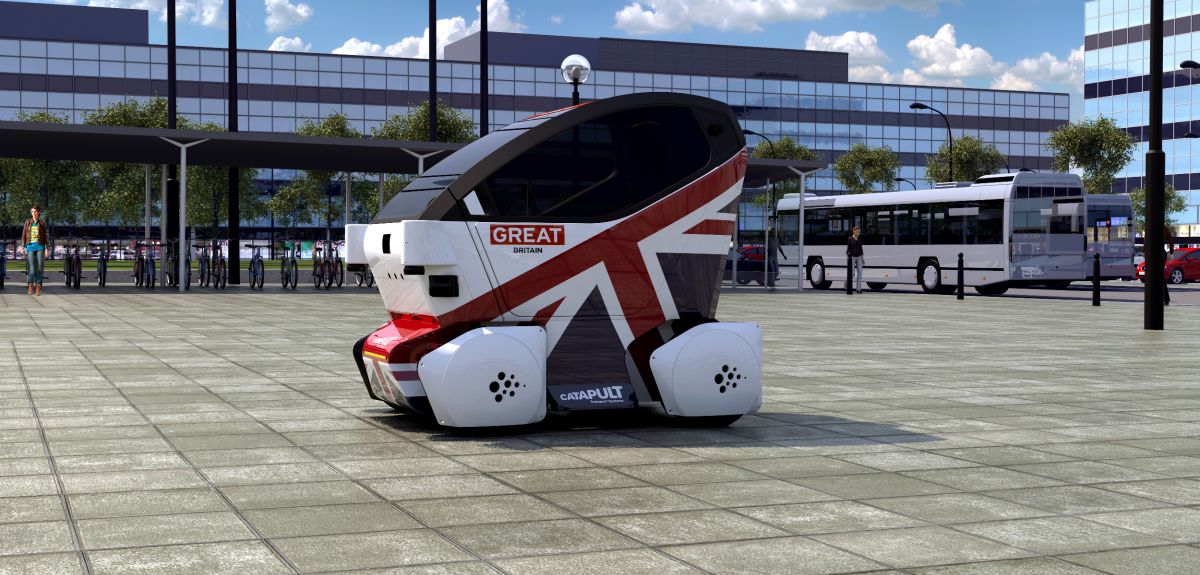
Image: Transport Systems Catapult
8 things about Oxford’s driverless tech
Today, at an event in London, the government has revealed the outcome of a review of UK regulations for driverless cars as well as the launch of trial projects in three locations.
Today is also the first chance to see prototype driverless LUTZ Pathfinder pods built for one of the trials being driven around pedestrianized areas in Milton Keynes.
The Mobile Robotics Group (MRG) at Oxford University's Department of Engineering Science is involved in both announcements and has been at the forefront of autonomous vehicle research in the UK for over a decade, here's a brief run-down of what you need to know:
1. Oxford tech is in the LUTZ driverless pods
Technology developed at Oxford University's Mobile Robotics Group (MRG) is at the heart of the LUTZ Pathfinder pods. It enables the pods to navigate and understand their environment, so knowing exactly where they are on a pavement or pathway and being able to recognise and avoid pedestrians and obstacles. The Oxford team will be working with the Transport Systems Catapult (TSC) and project partners over the coming months to build autonomous systems into the pods, eventually doing away with the need for a steering wheel or human driver.
2. Wildcat shows off early tech back in 2011
The Oxford researchers first showed off their autonomous technology in March 2011 installed in a Bowler Wildcat 4X4 built by BAE Systems. Data gathered from cameras and lasers mounted on the Wildcat could be processed on board fast enough to be used in navigation and it was demonstrated driving around Begbroke Science Park, near Oxford. Coming only a year after Google announced it was testing driverless vehicles on California roads the Wildcat was a trail-blazer for autonomous vehicle research in the UK.
3. Does not rely on GPS to navigate
Oxford's autonomous vehicle tech does not rely on GPS to navigate because GPS doesn't work well in built-up environments and is in any case not precise or reliable enough to give an exact location. Neither does the Oxford approach use embedded infrastructure such as beacons and guide wires, which often guides robots in factories, as this would be impractical and far too expensive for use in most environments.
Instead the Oxford approach to navigation uses algorithms that combine machine learning and probabilistic inference to build up maps of the world around it using data form on-board sensors and 'learn as it drives'. The maps it builds (and updates) are like memories of a route which can be accessed to allow the vehicle to guide itself through places it has been before.
4. Robot Car demonstrated in 2014
February 2014 saw the first public demonstration of the Oxford Robot Car: Oxford University technology installed in a modified Nissan Leaf electric car that enables the vehicle to drive itself for stretches of a route. Robot Car was shown driving autonomously around private roads at Begbroke Science Park with the driver able to take his/her hands off the wheel as the car steered itself and stopped when confronted with an obstacle, such as a pedestrian walking out into the road.
The technology is controlled from an iPad on the dashboard which flashes up a prompt offering the driver the option of the car taking over for a portion of a familiar route – touching the screen then switches to 'auto drive' where the robotic system takes over. At any time a tap on the brake pedal returns control to the human driver.
For a long time Robot Car was the only autonomous vehicle in the UK with permission to go on public roads and the team's work in collaboration with the Department for Transport fed into the government's legislative review. Development of the Oxford Robot Car continues alongside the technology for the LUTZ pods and the team's other robotics research .
5. Blueprint for a low-cost system
One key aim of the Oxford research is to produce autonomous systems that are affordable and would be relatively simple to build into ordinary vehicles. The approach is made possible by advances in 3D laser-mapping that enable a system to rapidly build up a detailed picture of its surroundings. The 2014 Robot Car demonstration showed that the combination of this laser-mapping, cameras, and the team's clever software, can enable a vehicle to learn to navigate a route and know exactly where it is on the road. The system used for the demonstration was estimated to cost around £5000 but the team believe that systems that deliver limited autonomy – driving you 'some of the time in some of the places' – could eventually cost around £100.
6. Robot Car is being tested around Oxford
What does the world look like to a driverless car? As Oxford researchers continue to develop all the components needed for a complete system to drive itself on the public road the team has released new videos from tests around Oxford. The videos show how some of Oxford's most iconic locations – including the Sheldonian Theatre on Broad Street – are mapped and interpreted by the technology. The footage also shows how the system detects people and other traffic.
7. Self-driving or driverless?
Whilst the ultimate vision is for a car to drive itself without the need for any intervention from a human driver there are likely to be many stages on the road to fully autonomous vehicles. During the 2014 tests of Robot Car a trained human driver was behind the wheel at all times to take over control whenever necessary and this is also true of all current testing – in this sense they are not yet 'driverless'. Initial autonomous systems for cars are likely to be able to drive 'some of the places some of the time' offering to take over familiar routes such as the school run or daily commute. However, systems for vehicles such as the LUTZ pods that are designed to drive at lower speeds in less hazardous pedestrianized environments, may be able to achieve full 'end to end' autonomy sooner, doing away with the need for a driver altogether.
8. It’s not just about driverless cars…
Driverless cars may hog the headlines but the same Oxford University technology in both the LUTZ pods and Oxford Robot Car has many other applications. Current MRG projects include robotic survey systems for roads and railways and robotic rovers for use on other planets. In November 2014 Professor Ingmar Posner and Professor Paul Newman, leaders of the Oxford Mobile Robotics Group (MRG) founded a new spin-out firm, Oxbotica, to commercialise MRG's robotics and autonomous systems technologies.
 A song of fire and ice in the ocean
A song of fire and ice in the ocean Bubble research rises to the top
Bubble research rises to the top Seashells and sediment: measuring oxygen
Seashells and sediment: measuring oxygen  Coming Soon: the Universe in 3D Widescreen
Coming Soon: the Universe in 3D Widescreen Economic games don't show altruism
Economic games don't show altruism